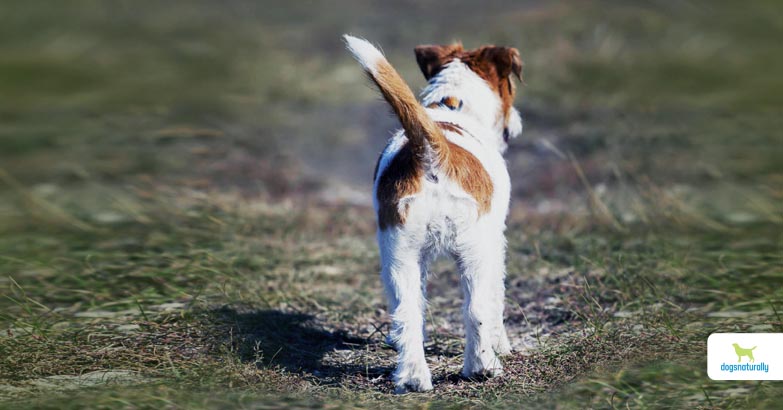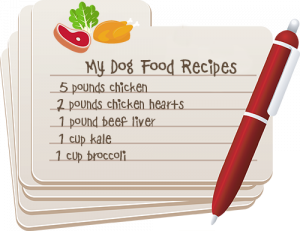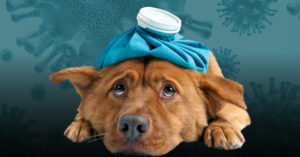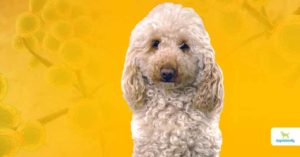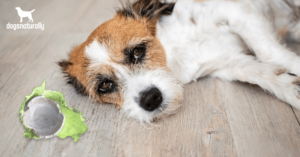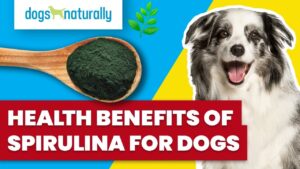Dog anal glands smell bad from time to time … but it can be easy and cost-effective to help dogs learn how to express dog anal glands on their own.
Sure, it’s not the most pleasant subject (even for dog lovers), but it’s an important part of your dog’s health. So we’ll show you how to help your dog’s anal glands express themselves naturally.
But first, let’s look at why your dog has anal glands …
Why Do Dogs Have Anal Glands?
You know your dog marks his (or her – girls do it too!) territory with his pee, but did you know your dog’s anal gland expression helps him mark with his poop?
First of all, let’s be clear about what these anal glands or anal sacs are. Technically, the anal glands aren’t glands at all. In fact, they’re sacs. Each anal sac contains oil and sweat glands. They have small receptacles of foul-smelling liquid … a lot like skunks! Your dog has two anal glands, under your dog’s tail near the anal opening on your dog’s anus, at 4 o’clock and 8 o’clock. The glands can empty when your dog poops, or when he’s stressed.
When the glands express, they can create a very sudden, unpleasant change in your dog’s odor. So when dogs sniff each other’s butts, it’s like checking a human passport! Sniffing another dog’s rear tells your dog a lot about that other dog.
But there are times when things can go wrong with the anal glands.
Symptoms Of Impacted Anal Glands
Just like us, dogs need fiber in their diet. But many of us seem to think we can feed mushy puréed foods … and expect our dog’s anal glands to work just fine. This is why dogs need fiber.
Fiber helps dog anal glands work properly. It helps prevent anal gland irritation. But most commercial dog diets don’t have much fiber. So, a lot of dogs need their anal glands expressed manually. That means the vet or groomer squeezes them by hand to get the fluid out.
Over the last few decades, anal gland issues have been a pain in the butt for both dogs and cats. While most dogs do fine, some research shows that 12% will get anal gland issues.
You’ll notice something’s wrong when you see your dog …
- Dragging his butt on the ground – scooting
- Licking or biting at his butt
- Sitting uncomfortably
- Having difficulty sitting or standing
- Even chasing his tail
As long as the ducts in the anal glands are open and the consistency is liquid enough, your dog will be fine. But over time, chronic disease can create a blockage in the ducts. These anal gland issues become an acute symptom of that chronic disease.
What Causes Impacted Dog Anal Glands?
The main suspects are drugs and chemicals, poor nutrition and vaccines. The body tries to get rid of these toxins through the skin, the liver, and even the anal glands.
Diet plays a big role in anal gland issues for most dogs. That’s because processed foods and even some raw foods are too soft. When the diet contains the right fiber, it promotes a good wide push of the anus during defecation. This pressure helps to express the anal glands. When that doesn’t happen, your dog’s anal glands and their ducts can swell shut. Or their discharge can become so thick, your dog can’t pass it.
Some veterinarians will suggest removing your dog’s anal glands. Don’t do it! That’s the worst possible thing you can do. It can cause permanent damage to the anal sphincter. And it prevents the body from cleansing itself. Toxins that would normally exit through the anal glands go deeper into your dog’s body … causing more health issues.
So … what’s the answer to this icky problem?
How To Express Anal Glands Naturally
We’ll talk about some steps you can take to prevent anal gland issues. But if your dog’s already got a problem with his anal glands, here’s what to do.
Noticing a fishy smell and wondering how to get rid of dog gland smell in your home? Don’t worry, once the anal glands drain, that stinky problem should resolve on its own.
Calendula Compress
First, you can relieve the irritation with this soothing compress.
- Put a teaspoon of sea salt in a cup of warm water.
- Add 8 drops of calendula tincture to the mixture.
- Pour it onto a cloth and hold it against the inflamed area until the cloth is cool.
- Repeat the process every hour until the swelling goes down or until the glands open and drain.
Homeopathic Silica
There’s an excellent homeopathic remedy for anal glands. It’s called Silica (or Silicea). Use it when your dog needs a little help emptying his glands. Silica is a remedy that helps the body expel foreign objects … and fluids like pus and excretions (you can also use it for things like splinters and fox tails in the skin). You can buy Silica 6C at most health stores or on Amazon.
Give your dog the Silica 6C twice a day for 2 to 7 days. Here’s how to do it…
- Try not to touch the pellets with your hands as that can spoil the remedy.
- Put about 3-5 pellets into a small glass of filtered or spring water (don’t use unfiltered tap water).
- Stir vigorously with a spoon for about 20-30 seconds,
- Use a glass dropper or teaspoon to place some of the liquid on your dog’s gums twice a day.
- Stir the liquid again before every dose.
- Make sure he doesn’t eat for 20 minutes before and after dosing.
- If your dog is really freaked out that you’re chasing him around with the spoon … you can put the pellets in his water bowl (stir well and use filtered water). This will work just as well. as long as you don’t have other dogs who use the same bowl.
A Natural Food To Help Your Dog’s Anal Gland Expression
Fiber broth is a food to help dogs express anal glands. It acts as a colon cleanse and can help with your dog’s anal gland problems. Psyllium is a great food to help dogs express glands … it creates bulk to stimulate better muscle movement in the intestines. Phivo Christodoulou shared this great fiber broth recipe you can make at home.
Please read ALL the directions before feeding. It’s important to follow this recipe carefully. Psyllium husk sucks moisture out of the digestive tract … and can cause constipation if over-fed.
Psyllium Husk Recipe:
- 1 cup of bone broth
- 2 tbsp psyllium husks
- Heat bone broth and add psyllium husks
- Mix with a spoon until it’s a jelly-like consistency (should only take a few minutes)
- Allow mixture to cool
- Feed as a meal replacement every other meal for 1-2 days until stools are firmer or until you can confirm the anal glands have expressed
How Much To Feed Your Dog
Miniature or small breed dogs … 1/5 to 1/4 cup per meal Medium to large breed dogs … ½ to ¾ cup per meal Giant breed dogs … 1 cup per meal
In a pinch, you can also use water instead of bone broth. The bone broth is for extra nourishment. It also helps add flavor to encourage your dog to eat the broth. If your dog will drink a mixture made with water that’s fine too.
If your dog’s poops are still not large enough, you can slowly increase the amount of psyllium husk.
And there’s one more thing…
Supervise your dog during poop time while you’re feeding the fiber broth. This is gross, but some dogs may need help getting their poop out at first. If he’s having trouble, place your hand in a clean poop bag and pull the poop out. Your hands won’t get dirty so grit your teeth, hold your nose, and give your dog a hand if he needs it.
Note: This psyllium husk broth Is a great way to help your dog’s express his anal glands. Other choices include fiber from the skins of pumpkin squash. Apples can also add beneficial insoluble fiber to your dog’s homemade diet.
How To Express Anal Glands Naturally
Now that you know how to better manage healthy dog anal glands, here are some DOs and DON’Ts to prevent this from happening again down the road.
DON’T … Express Your Dog’s Anal Glands
Expressing your dog’s anal glands means manually squeezing them (often with the thumb and index finger) to remove the fluid. Some groomers and vets do this routinely … and they may tell you to do it yourself too.
Don’t do it and don’t let your groomer or vet do it either! When you drop your dog off at the groomer, tell them you don’t need this service. Expressing anal glands should happen naturally.
DO … Feed A Raw Diet
One of the most common causes of a dog’s anal gland problems is diet. Kibble diets cause mushy stools that don’t force the glands to empty.
Vets often recommend a high fiber diet to firm up the soft stools that commercial dog foods can create. But a much more effective solution for dog anal glands is to feed a raw diet that includes bone content.
Bones in the diet dissolve during the digestive process. This helps create those small firm poops raw feeders are so proud of! Raw feeders are proud poop experts … and one type of poop they recognize is “bone poop.” When dogs eat a meal that’s higher in bone content, like chicken backs or turkey necks … the result is a small but hard stool.
This firm stool pushes against the anal glands when your dog poops, causing the glands to empty. But sometimes these poops are still small … so don’t forget to add those fibrous fruits and veggies to increase stool volume. Feeding a raw diet is one of the best ways to naturally support your dog’s anal glands at home.
DO … Give Probiotics And Prebiotics
Giving probiotics for dogs and prebiotics can help firm up stools. You can feed:
- Fermented foods like kefir
- Fermented veggies
- Or buy a prebiotic and probiotic supplement
DO … Exercise Your Dog
Make sure your dog gets plenty of walks. Regular exercise strengthens his rectal and abdominal muscles. This gives your dog the strength to put more pressure on the anal glands. Exercise also helps stimulate bowel movements so your dog poops more often.
DO … Treat Allergies
Food allergies and sensitivities can be a common cause of issues with dog anal glands. You need to address his allergies, or he’ll have irritated anal glands. People often think of food as the culprit … but environmental allergies can also be at play. Work with your holistic vet to resolve your dog’s allergies.
Can A Dog Express Their Own Glands?
Kibble diets cause mushy stools that don’t force the glands to empty. Vets often recommend a high fiber diet to firm up the soft stools that commercial dog foods can create. But a much more effective way to help dogs express their own glands is to feed a raw diet that includes bone content.
How Do You Express A Dog’s Anal Glands?
Despite what vets and groomers tell you, your dog shouldn’t need his anal glands expressed. All that repeated squeezing and pinching can cause more inflammation, swelling and injury. And regular expressing can make the anal glands dependent, which means they won’t work well on their own.
If you feel you need veterinary help when it comes to dog anal glands, it’s best to find a holistic veterinarian. She’ll understand this chronic disease and how to manage it. She’ll work with you on treatment plans that don’t include the conventional approaches of regular anal gland expressing …along with drugs, chemicals or surgery.
Keep in mind that dog anal glands disease is not a standalone diagnosis. View it as a red flag that your dog is toxic and needs a little help getting squeaky clean again. That’s the holistic view of anal gland expression problems.
FAQ
Can I express my dogs glands myself?
Yes, you can technically express your dog’s anal glands yourself with the proper technique and care. However, this can lead to anal gland infections, an impacted anal gland, and other chronic issues. Instead, we recommend you let your dog’s anal gland express themselves naturally.
What happens if you don’t express your dog’s glands?
If a dog’s anal glands are not expressed when needed, it can lead to discomfort, swelling, and potential blockage, known as anal gland impaction. In severe cases, an anal gland issue can lead to infections or abscesses, requiring medical intervention or surgery.
References
Tortola L, Brunetto M, Zaine L, Vasconcellos R. The use of psyllium to control constipation in dogs. Ciência Rural. 2009 Dec;39(9):2638-2641.

